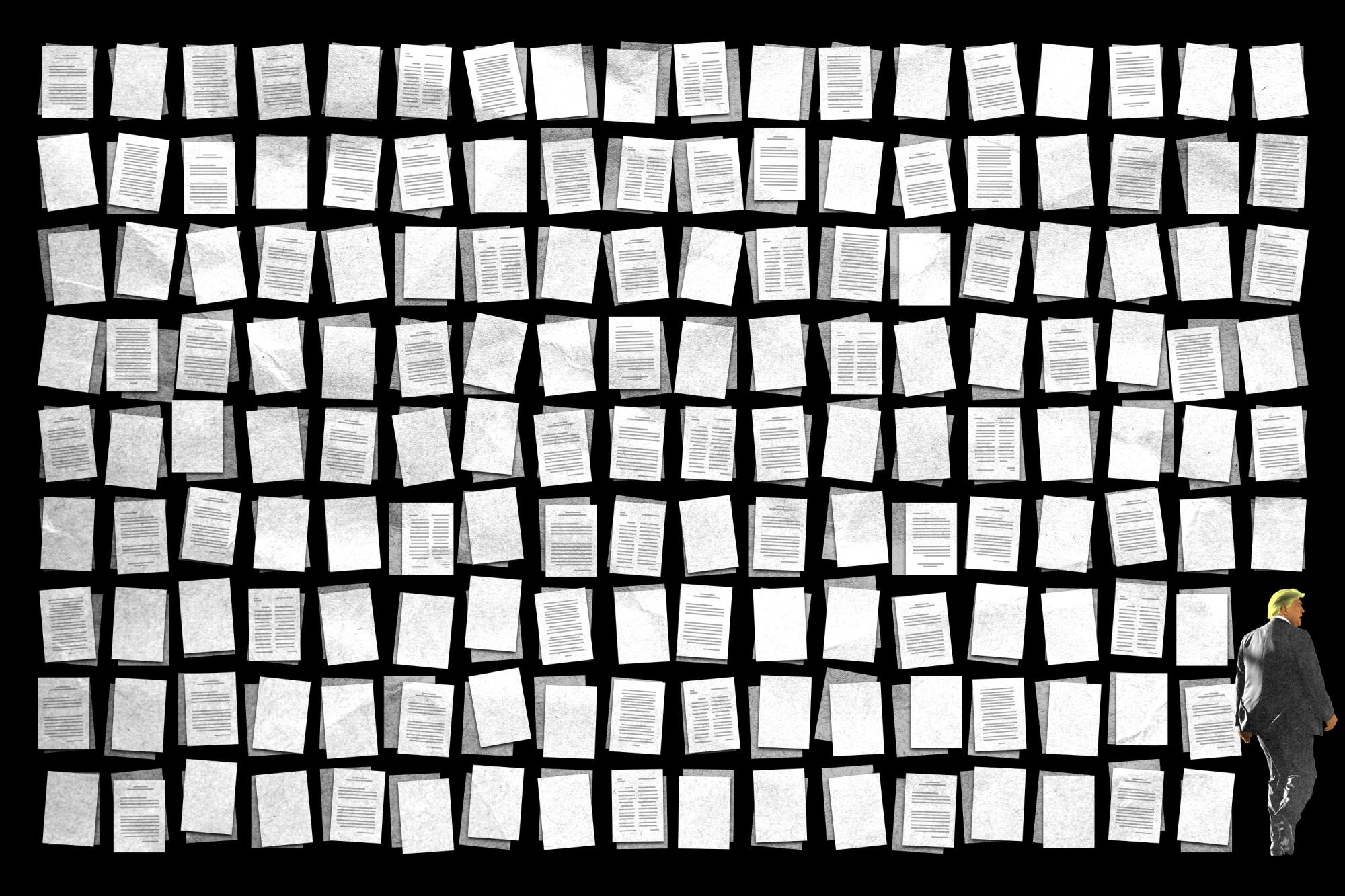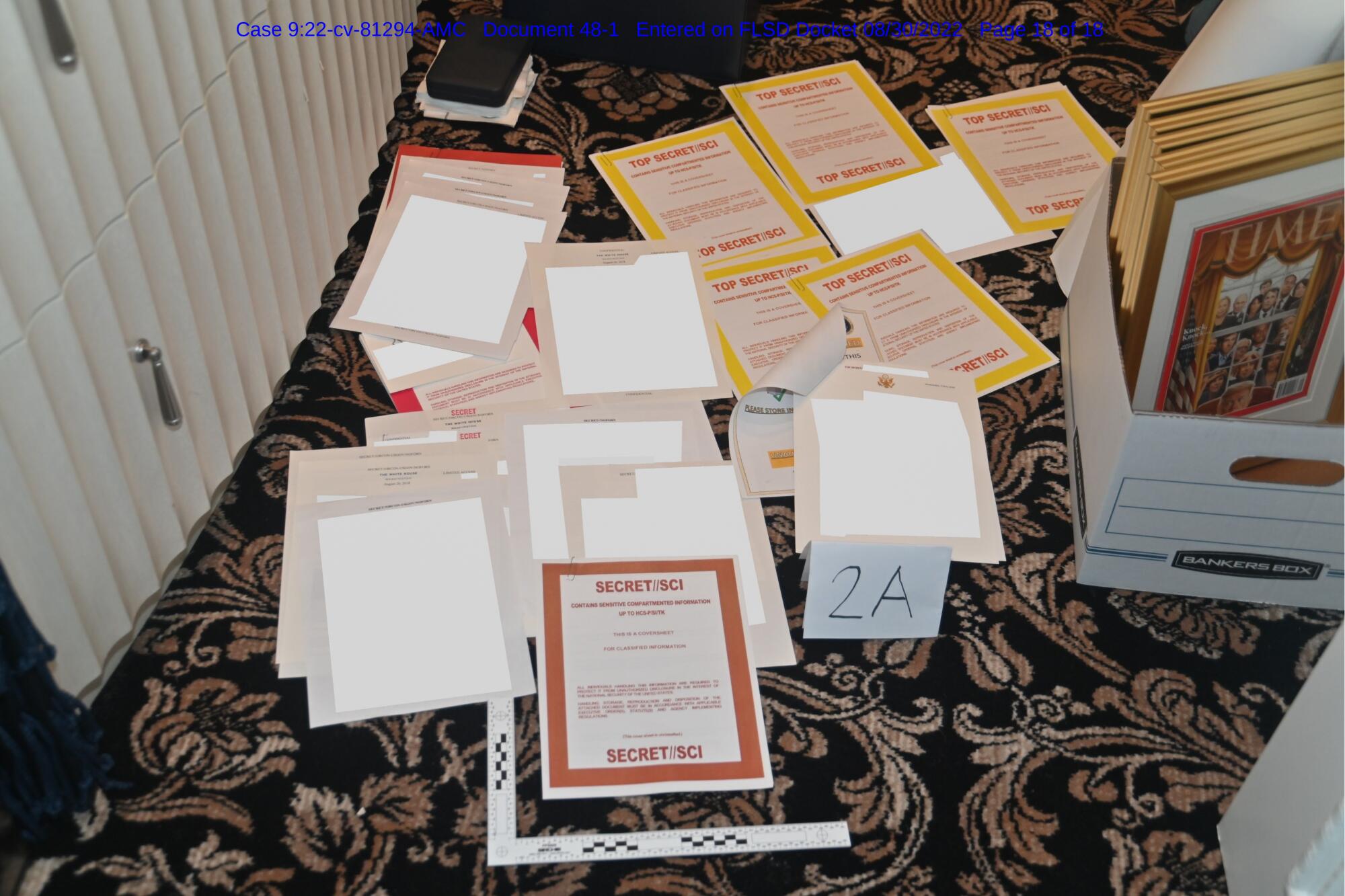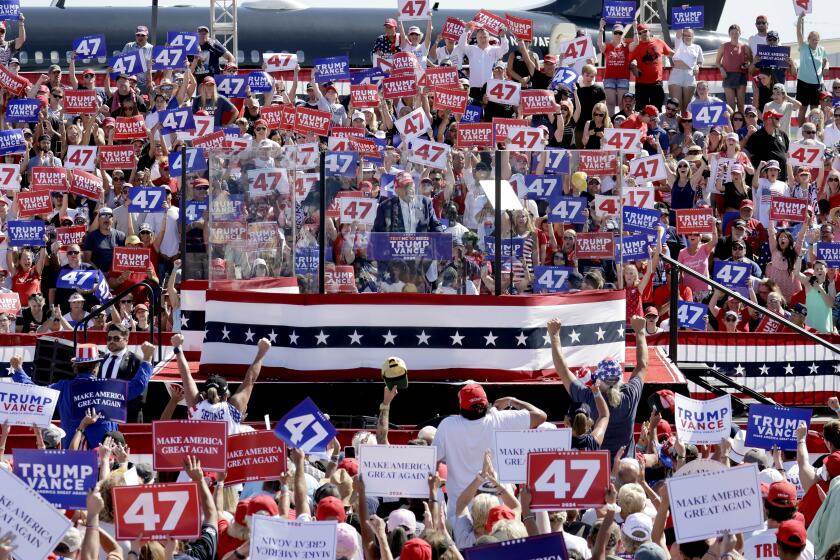
- Share via
WASHINGTON — As questions continue to swirl about the 11,000 records the FBI recovered during its raid of former President Trump’s Florida home, Congress has asked the National Archives to provide it with a preliminary report by Tuesday detailing what Trump presidential records might still be missing.
The National Archives and Records Administration hasn’t formally responded. But given the realities of what goes into processing presidential records, and questions about the quality of record-keeping in the Trump White House, experts told The Times the archives might not have a firm grasp of what is missing for years — if ever.
“It is unreasonable to expect that [national] archivists are in a position to say at this time what additional records may be missing,” said Jason R. Baron, former director of litigation at the National Archives.
Processing presidential records for eventual public use is a painstaking process that can take decades. At minimum, the National Archives has five years before the public can request access to a president’s records, but that doesn’t mean all of the material will be ready for public use by then. The Presidential Records Act also lets presidents restrict certain categories of records, such as confidential communications with advisors, for up to 12 years.
Alongside the Justice Department’s criminal investigation, which is focused on whether Trump improperly held onto classified materials, the House Committee on Oversight and Reform has been investigating whether Trump mishandled presidential records since news leaked in January that the National Archives had recovered 15 boxes, including some containing classified materials, from his Mar-a-Lago estate and resort in Palm Beach, Fla.
The Oversight Committee has held no public hearings on the topic, and a spokesperson declined to discuss what investigatory steps it had taken.
In last week’s letter requesting the National Archives review, the committee’s chairwoman, Rep. Carolyn B. Maloney (D-N.Y.), told acting National Archivist Debra Steidel Wall that Trump’s repeated refusal before the FBI raid to hand over records, even when subpoenaed, had the committee “concerned that ... Mr. Trump may continue to retain presidential records at non-secure locations, including classified material that could endanger our nation’s security and other important records documenting Mr. Trump’s activities at the White House.”
Maloney cited an Aug. 24 phone call in which she said National Archives staff warned that the agency was not certain whether all presidential records were in its custody.
She also asked the National Archives to seek “a personal certification from Donald Trump that he has surrendered all presidential records that he illegally removed from the White House after leaving office.”
A National Archives spokesperson declined to comment for this article. Wall responded Wednesday to a separate request from Republicans on the House Oversight Committee for information about the agency’s role in the Mar-a-Lago search by saying, “As a general matter, the Department of Justice has requested that [the National Archives] not share or otherwise disclose to others information related to this matter at this time in order to protect the integrity of DOJ’s ongoing work.”
What information the National Archives can provide by Tuesday is likely to be incomplete and unsatisfying to Congress.
“It takes archivists decades to process presidential collections. There are still parts of the Nixon administration that [are] not processed,” said historian Timothy Naftali, who was director of the Richard Nixon Presidential Library in Yorba Linda from 2007 to 2011.
“It’s not like the National Archives can flip a switch” and account for every document, but it “could certainly get a sense for possible holes,” Naftali said.
Preserving presidential records typically begins in the early days of an administration. Tutorials by the National Archives are available to the president and his staff to teach them what qualifies as a presidential record, along with recommendations on making the preservation process easier, such as filing personal records separately from presidential records, said Trudy Peterson, who as an archives employee helped set protocols for preserving presidential records after the 1978 Presidential Records Act became law. In 1993, she became the first woman to lead the agency in an acting capacity under then-President Clinton.
Presidents are legally responsible for preserving their documents until they leave the White House, but archives staff are available to provide advice during their administrations, and will often nudge high-ranking officials when they hear that records aren’t being properly retained.
Single-term presidencies are notoriously difficult for the National Archives, because no one in the White House wants to plan for where documents will be stored or even to start boxing them up before the election results are announced, Peterson said.
But normally after a week or two, staff start coordinating the move. With Trump focused on fighting his election defeat well into January 2021, what is customarily a routine process was likely far more compressed and chaotic.
In the final days of an administration, archives employees traditionally remind White House staff to turn over documents and help pack and move hundreds of thousands of boxes of paper and other items, such as gifts that the president received from foreign leaders, as well as countless electronic records.
The entire process of gathering and moving paper records can take weeks, or in the case of electronic records, months. The National Archives didn’t receive copies of Trump’s electronic presidential records until November 2021, almost a year after President Biden took office.
News of hundreds of missing classified documents recovered from former President Trump’s home has the intelligence community reeling and the public asking: “How could it happen?”
But the National Archives became the legal custodian of Trump’s presidential records on Jan. 20, 2021. Its staff likely followed regular procedures and first created a catalog outlining how much material it had received from each White House office and where in the collection it was located, Peterson said. The archives’ catalog would be built using office indexes or logs made while packing, she said.
“First you try to see, what do we have? And do we have things from every place that we’re supposed to have things from? Do we have all the electronic records that are supposed to be coming in from all the staff aides? You try to figure out what you’ve got, basically,” Peterson said.
“Within a couple of months, you know where you are,” she continued. “You don’t know much about it, but you know what you got from where, you know volume, and you know which offices have indeed turned over the records as required.”
The National Archives first started asking questions about misplaced documents four months after Trump left Washington. Months of negotiations with his team resulted in Trump handing over 15 boxes of presidential records in January of this year, including news clippings, mementos and nearly 200 classified documents.
How archives officials knew to ask questions so quickly has not been made public. Peterson speculates that the National Archives started asking why it hadn’t received records from certain White House staff and that the questioning escalated from there.
Archivists may have also noticed problems with how records were filed while they helped pack up the White House in the administration’s final days, Naftali said, and inquired about the location of high-profile documents that were known to exist but were not found with the records.
For example, the original copy of a letter that former President Obama left for Trump when he was first sworn in, and letters to Trump from North Korean leader Kim Jong Un, were reportedly among the 15 boxes recovered this January.
Or it could be that someone with direct knowledge warned National Archives staff that something was amiss.

“It’s a lot harder to figure out if a document is missing. You might know that the file should exist. But if there are only four documents in the file instead of seven, it might be very hard to know the three are missing, unless someone on the inside has told the archives, you know, ‘The president was really interested in this particular issue, and he took it to Mar-a-Lago,’” Naftali said. “So a lot of this, I think, depends on the nature of what record keepers in the Trump White House were telling National Archives professionals.”
Archives staff routinely communicate with their counterparts in the White House records office to answer questions or give advice. Rank-and-file White House records staffers often stay on between administrations or follow the records they’ve been handling to the National Archives once a president leaves office. About half of the records staff in place when Trump took office were still there when Biden came to the White House, according to personnel reports submitted to Congress. All but one person employed in the records office when Trump left was still employed under Biden as of June.
Peterson said that at this point in the process, the initial catalog of what the National Archives obtained from the White House should help the agency at least tell Congress whether it received the expected volume of materials from a particular White House office or staff member. Any logs created by White House staff tracking the movement of paper records would be “gravy,” she said, particularly logs maintained by the National Security Council, which controls classified information.
“It would be a massive job to take that log and match it against what you physically have. It could be done, but it wouldn’t be fast,” Peterson said. “And as I looked at what Rep. Maloney wanted — the time schedule is so tight, that I doubt that they can do much of that kind of comparison, even if they have logs that would allow them to do so.”
It may never be completely clear what gaps exist in Trump’s presidential records. Cataloging the contents of every file in hundreds of thousands of boxes produced during a single presidential term will take years, if not decades.
High-ranking administration staff conducted official business on personal email or private chat applications like WhatsApp despite reminders from the National Archives that the work had to be preserved for the public.
And this February, the National Archives notified the Oversight Committee that the White House hadn’t fully preserved social media posts from Trump or several other prominent administration officials, and that some posts were potentially lost forever.
How long it takes to process a president’s records depends on how much was turned over to the archives and what organizational state the information is in, Peterson said. Archivists would normally focus on items of public, historical or educational interest first.
But the National Archives is likely to prioritize the committee’s request, particularly identifying whether any other classified materials were mishandled, Peterson said. That will require pulling archives employees who have security clearances off their day jobs processing materials from the CIA and Pentagon or at presidential libraries across the country, she said.
Peterson said she hopes oversight officials will give the National Archives a more reasonable timeline.
“It isn’t just a warehouse, and it isn’t like an Amazon order picker, where you can go along and read a bar label,” she said.
Maloney’s letter asked for the speedy review partly due to the possibility that presidential records were taken to other Trump properties. Conversations could already be going on behind the scenes about recovering records from Trump’s other homes.
Archivists have historically preferred to negotiate records disputes quietly with a former president’s representatives, but that might not be possible in this case, because the Justice Department is involved.
Former Archivist David Ferriero told the House Oversight Committee in February that the agency had asked the Justice Department to intervene because the 15 boxes returned by Trump in January included so many classified records. The FBI’s search of Mar-a-Lago on Aug. 8 likely soured any relationship that may have existed with Trump’s representatives.
Based on public records, the FBI investigation appears to have targeted the Palm Beach estate, where the original 15 boxes came from — but Trump also spent time during his presidency at the Trump National Golf Club in Bedminster, N.J., at his suite at the Trump Hotel in New York City, and at other properties he owns.
“Under the present circumstances,” said former archives litigation director Baron, “[National Archives] staff would likely defer to the DOJ and law enforcement to pursue further leads on whether missing presidential records from the Trump Administration exist in still other locations.”
More to Read
Get the L.A. Times Politics newsletter
Deeply reported insights into legislation, politics and policy from Sacramento, Washington and beyond. In your inbox three times per week.
You may occasionally receive promotional content from the Los Angeles Times.











